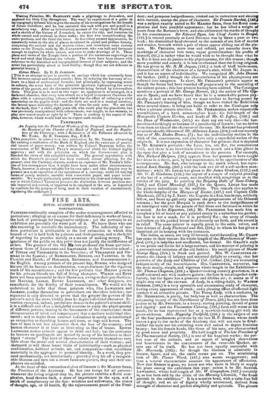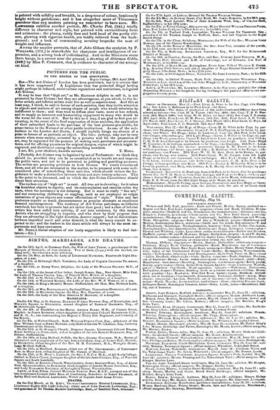FINE ARTS.
ROYAL ACADEMY EXHIBITION.
PORTRAITURE.
PAINTERS continually complain of the undue encouragement afforded to portraiture ; alleging, as an excuse for their deficiency in works of fancy, the lack of patronage for imaginative subjects : yet the portraits in an exhibition are generally the worst part of it. We leave those who use this reasoning to reconcile the inconsistency. The inferiority of mo- dern portraiture is attributable to the low estimation in which this branch of art is held both by painters and their patrons, and to the habit of regarding its practice merely as a means of making money. The ignorance of the public on this point does not justify the indifference of artists. The greatest of the Old Ma ,ters produced the finest portraits : witness those of LEONARDO and RAFFAELLE in the Florentine school ; of TITIAN and TatiTortETTo in the Venetian ; of VELASQUEZ and Mu- grew in the Spanish ; of REMBRANDT, RUBENS, and VANDYKE, in the Flemish and Dutch; of HOGARTH, REYNOLDS, and GAINSBOROUGH in the English. Among painters of the present day, BRIGGS, who designed history till he became an Academician, was preeminent for the vigorous truth of his resemblances ; and the few portraits that HILTON painted for his private friends are full of living character. WILKIE and ETTY have not been successful in their likenesses, owing to their peculiarities ; but MAGLISE, LESLIE, EDWIN LANDSEER, and other designers, are remarkable for the fidelity of their resemblances. We would not be understood to infer that those painters who, like LAWRENCE and Jacason, confine themselves to portraiture are therefore inferior; our argument is only directed to prove that the greater the powers of the painter's mind the more vividly does he depict individual character. In- vention excepted, indeed, portraiture demands the painter's utmost skill: it is a difficult and often a delightful exercise to study the physiognomy of different persons, tracing in the lineaments of the countenance those idiosyncracies of mind and temperament that constitute individual cha- racter; and to depict these external indications is surely as intellectual an occupation as sketching houses and trees, or dogs and horses. The face of man is not less expressive than the face of the country ; and human character is at least as interesting as that of brutes. EDWIN LANDSEER makes animals appear to think and feel ; but the attributes he bestows on quadrupeds are denied by many of his brethren to their biped "sitters." The herd of likeness-takers concern themselves very little about the moral and mental characteristics of their victims ; and disregard at will those lesser traits of individuality—such as physical conformation, habitual attitude, air, and complexion—that contribute materially in the aggregate to personal identity. In a word, they pro- ceed mechanically, not intellectually : provided they bit off a recogniz- able likeness and turn out a smart furniture-picture, they and their em- ployers are satisfied.
At the bead of this conventional class of limners is Sir MARTIN SHEE, the President of the Academy. He has one recipe for all persons : whatever the living original may be, his picture exhibits a florid com- plexion, head thrown hack, a stare of importance in the eyes, and a smirk of complacency on the lips: wrinkles and sallowness, the traces of thought, age, or ill health, fig the rejuvenesceut pencil of the Presi- dent ; and pompons insignificance, tricked out in carnations and 'shining with varnish, usurps the place of character. Sir Francis Burdett, (1,83,) was a subject exactly suited to Sir MARTIN SHEN, from his florid cane plexion and hale youthful appearance; but he has lifted a weight at years from the Baronet's brow, and also obliterated the marks of thought in his countenance. Sir Edward Ryan, late Chiqf Justice its Beng4 (121,) is treated precisely as Lord Denman was by SHER a year or two back ; his diminished head elevated to the summit of six feet of scarlet and ermine, beneath which a pair of shoes appear sliding out of the pic- ture. Mr. PHILLIPS, more true and refined, yet smooths down the markings of character into tame, vague generalization: his profile of himself, (61,) is rather what he would wish to be thought than what he is. Yet it does not do justice to his physiognomy, for this reason; though more youthful and comely, it is less intellectual than the living origin& He has given to Mr. R. M. Jaques, (116,) a look of bluff bonhommie, characteristic of the chairman of a farmer's club, which Mr. Jaques is; and it has an aspect of individuality. We recognized Mr. John Deacon the banker, (439,) though the characteristics of his physiognomy are softened into smugness. [n short, Mr. PHILLIPS'S portraits appear at though the forms had been rounded off preparatory to the accenting of the salient points ; this last process having been omitted. The Catalogue mentions a portrait of Mr. George Borrow, (8,) the author of The Gip.. sies in Spain; and we have heard that he is a remarkable person phy- sically us well as mentally : yet we must confess to having passed by Mr. PHILLIPS'S limning of him, though we have visited the Exhibition three several times ; it being our habit to refer to the Catalogue onlir when a picture attracts attention. Mr. PICHERSGILL makes respectable resemblances, of a hard, commonplace kind : his fall-length of the Honourable Captain Gordon, and heads of Mr. G. Loftus, (189,) and the Dean of Westminster, (415,) we dare say are very like—the last- mentioned strikingly so because of a peculiarity of feature ; but we derive from them no idea of the character of the men. Mr. KNIGHT has produced an unmistakeable likeness of Mr. Alderman Lucas, (204,) and one scarcely less so of Mr. Daden Brown, (7); but the individuality resides in the trick of the countenance, and you have only a superficial notion of the originals. It is not expression of character but grimace that is depicted in Mr. KNIGHT'S portraits : the faces, too, are flat, the complexions livid, and there is an incertitude about the mouth and a false glitter in the eyes that give a look of uneasiness to the persons. For example, Mrs. Richard Hodgson, (30,) appears from her posture to have caught her dress in a thorn, and, by her countenance, to be apprehensive of the consequences. Mr. SAY, who belongs to the smirk school, has repre- sented Lord Stanley, (347,) with the look and air of a soft-spoken man- milliner ; while Mr. Lucas has given to Sir James Graham, (117,) and Mr. W. E. Gladstone, (135,) the aspect of a couple of culprits pleading at the bar of a criminal court, and troubled with misgivings as to the verdict of the jury. In painting the Reigning Duke of Saxe-Coburg, (3460 and Count Mensdorf, (357,) for the Queen, LUCAS has made the persons subordinate to the uniform. This remark also applies to the whole-lengths of the Marquis of Exeter, (497,) and Captain Colin Mackenzie, (373,) by J. SANT: the Captain is a flue, handsome, soldierly fellow, and bears up gallantly against the gorgeousness of his Oriental costume ; but the poor Marquis is sunk down to the insignificance of an intelligent valet by the parade of full dress and furniture in which he is seated. As for Espartero, (49,) Mr. PARTRIDGE has made him as complete a bit of board as any painted sentry in a suburban tea-garden: his face is not a mask, for it is perfectly flat ; the array of ribands and orders on his padded breast is elaborately set forth, and his sword is in relief. The same painter is equally great in the satin velvet, and lace dresses of Lady Fleetwood and Son, (254,) to whom he has given a theatrical air in keeping with the costumes. The ladies, as usual, are very ill-treated, notwithstanding Mr. GRANT has come to their rescue: his whole-length of the Marchionessof Water- ford, (176,) is ladylike and unaffected, but formal. Mr. GRANT'S style is too petite and feeble for a large canvass, and his manner of painting is a conventional imitation of the old fashion : his small picture of Master George Byng, (284,) is frank and genteel. Mrs. W. CARPENTER ex- presses the charm of infancy and maternal delight so sweetly, that her portraits of the Lady and Children of Col. Michael, (56,) are interesting independently of the resemblances. Mrs. CARPENTER, moreover, haa the most manly, simple, and vigorous whole-length in the Exhibition— Mr. Thomas Chapman, (288,) a Quaker-looking country gentleman, in a snuff-coloured suit with leathern gaiters: the face is not altogether satis- factory, but the figure has a presence and lifelike air; it seems as if it might step out of the canvass. A Lady, in a riding-habit, by WATSON Gortnos, (140,) is a very agreeable and unassuming study of character, having every appearance of truth; and a pleasing effect ofreflected light renders it an attractive picture. The Young Lady, with a cockatoo, by Mr. MIDDLETON, is pretty, but bodyless as well as characterless. The surpassing beauty of the Marchioness of Douro, (20,) has not been done justice to by Mr. Switerost, in a heavy, staring painting, devoid of grace and dignity: and the Viscountess Canning, (191,) fares still worse at his hands, for he has represented her as a mawkish-looking girl with the green-sickness. Mrs. Hippisley Tuckfield, (386,) is the subject of one of the four posthumous portraits by the late H. P. Maims, whose death leaves a gap in the ranks of the Academy that will not soon be filled: neither his style nor his colouring were well suited to depict feminine beauty ; but his female heads, like those of his men, are characterized by good sense and propriety. His half-length of The late President of the Pharmaceutical Society, (57,) is one of his happiest works : the per- fect ease of the attitude, and an aspect of mingled shrewdness and benevolence in the countenance of the venerable Quaker, as- sure one of its truth. He has not been equally successful with Mr. Macready, (182); for though the likeness is admirable in feature, figure, and air, the smile seems put on. The scrutinizing look of Mr. Plurner Ward, (4870 also seems exaggerated; an thus a natural characteristic assumes the appearance of affectation. Now that Baeraas is gone, we know not who there is likely to supply his place among the exhibiters this year: unless it be Mr. Sanwa. LAWRENCE, whose half-length of Mr. W. Conyngham, (457,) certainly is, as has been said by the critic of the Morning Chronicle, "the finest portrait in the exhibition." It is a massive head, with a calm face fall of thought, and an air of dignity wholly unassumed, derived from strength of character and perfect simplicity and quietude. The picture. is painted with solidity and breadth, in a deep tone of colour, luminously bright without garishness; and it has altogether more of Titianesque grandeur than any modern painting we remember to have seen. Mr. LAWRENCE exhibits another portrait, Mr. Charles Pott, (245,) totally different in character and style, but painted with extraordinary force and animation : the plump, ruddy face and bald head of the portly citi- zen, glowing with vigorous health, are boldly relieved from the back- ground ; and a look of commanding scrutiny bespeaks the man of weight and influence.
Among the smaller portraits, that of John Gibson the sculptor, by P. WILLiews, (372) is remarkable for sharpness and intelligence of ex- pression, and a strong look of individuality. And in the Miniature-room there hangs, in a corner near the ground, a drawing of Alderman Gibbs, 0420 by Miss F. Con.isaux, that is evidence to character of the strong- est kind.



























 Previous page
Previous page